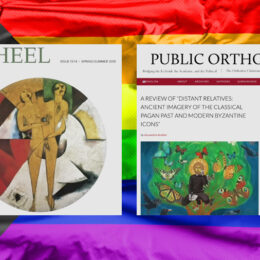link to legal brief: http://www.usccb.org/ogc/ashcroft2.pdf — Catholic Bishops Conference, Other Organizations, File Brief in Assisted Suicide Case WASHINGTON (May 6, 2005)
In a friend-of-the court brief filed today in the United States Supreme Court, the United States Conference of Catholic Bishops (USCCB) and other religious organizations declared that the U.S. Attorney General was correct in finding that assisted suicide is not a legitimate medical practice under the Controlled Substances Act. The amici asked the Supreme Court to reverse a Ninth Circuit decision striking down the Attorney General’s interpretation of the Act. The high court is expected to render a decision on the case, Gonzales v. State of Oregon, next term.
“The Attorney General’s conclusion that there is a difference between assisting suicide and managing pain, and that the former is not a legitimate medical purpose within the meaning of the Controlled Substances Act…while the latter is, is not only eminently reasonable but also supported by longstanding medical practice and past interpretation of the Act,” the brief said. “Enforcing the distinction leads to improvements in patient care. Blurring the distinction has been harmful to patients and jeopardized their care. Government does not serve the public interest or the common good by facilitating the killing of innocent people, regardless of their medical condition.” The brief noted that medicine by its very definition aims to prevent illness, to heal, and to alleviate pain.
“Taking a human life accomplishes none of these objectives. To say that it does creates an inherent contradiction, like saying that the legitimate practice of law includes helping clients break the law.” “What virtually every state regards as a crime, indeed as a form of homicide, does not become ‘medicine’ simply because the perpetrator is a doctor, the patient is terminally ill, or one state has decided to rescind its own criminal penalties for the act.”
The first part of the brief explains the fundamental difference between treating pain and assisting suicide, addressing the misconception that assisting suicide is simply a means of treating pain.
It notes that this distinction, and the understanding of assisted suicide as being outside the scope of legitimate medical practice, is consistent with longstanding tenets of the medical profession and past interpretation and enforcement of the Controlled Substances Act.
The second part of the brief explains how recognizing the distinction between treating pain and assisting suicide, and prohibiting the latter, has led to significant improvements in palliative care and in the ability of physicians to care for dying patients, while ignoring the distinction has had a deleterious impact on pain management and palliative care.
In addition to the USCCB, other organizations signing the brief are: the California Catholic Conference, Oregon Catholic Conference, Washington State Catholic Conference, Catholic Health Association of the United States, and Lutheran Church-Missouri Synod. The brief was submitted by Mark E. Chopko, General Counsel of the United States Conference of Catholic Bishops, and Michael F. Moses, USCCB Associate General Counsel. — U.S. Bishops File Brief in Assisted Suicide Case Supreme Court to Rule on Oregon Lawsuit WASHINGTON, D.C., MAY 10, 2005 (Zenit.org).-
The U.S. bishops asked the Supreme Court to uphold the attorney general’s interpretation of the Controlled Substances Act when deciding an assisted suicide case next term. In a friend-of-the-court brief filed today, the bishops, in conjunction with other religious organizations, requested that the court consider the conclusions of the office of the attorney general that found that assisted suicide is not a legitimate medical practice under the Controlled Substances Act. This interpretation was struck down by a Ninth Circuit court decision in the case Gonzales v. State of Oregon, now before the Supreme Court.
The attorney general concluded that “there is a difference between assisting suicide and managing pain, and that the former is not a legitimate medical purpose within the meaning of the Controlled Substances Act,” the brief said. “Enforcing the distinction leads to improvements in patient care. Blurring the distinction has been harmful to patients and jeopardized their care,” it stated.
The brief noted that medicine by its very definition aims to prevent illness, to heal, and to alleviate pain. “Taking a human life accomplishes none of these objectives. To say that it does creates an inherent contradiction, like saying that the legitimate practice of law includes helping clients break the law.”
Other organizations signing the brief are: the California Catholic Conference, Oregon Catholic Conference, Washington State Catholic Conference, Catholic Health Association of the United States, and Lutheran Church-Missouri Synod.




While I oppose assisted suicide, how does one tell the difference between a physician who’s prescribed Oxycontin for a cancer patient to “mitigate pain” and one who’s prescribed the same drug (and same dose) after saying, “Don’t take 20 of them with your Bourbon and Coke tonight, wink wink”?
Seems like it would be somewhat hard to prove, since the patient can also simply stockpile the meds to acquire the lethal dose if the physician doesn’t want to prescribe a too-obvious amount at one time.
James writes, “I oppose [physician] assisted suicide [PAS]” and then goes on to dismiss opposition to PAS because it is inevitable and impossible to prove.
I think JamesK is a pseudonym for John “I actually voted for the $87 billion, before I voted against it” Kerry.
I sincerely hope that the U.S. Bishops continually remind those in the medical profession of their oath to “first do no harm”. What I’m saying is that we cannot criminalize the act of simply providing information. Various drugs have various toxicities. For some, it may be 3,000-4,000 mg. For others it may be much less. For some narcotics, such as morphine, the dose can vary wildly depending on the degree of patient tolerance. Much of this information needs to be readily available, anyhow, in the event of accidental overdose.
While U.S. Bishops may state that it may be immoral for a physician to encourage or directly assist in the deaths of their patients, I can’t see how we can prosecute a physician who makes known to his or her patient what the “red line” level of a drug may be to a patient who requests that information.
Note: I said we can’t criminalize the providing of information. Now, if a physician actually prescribes a lethal dose, we might have a different story altogether. Example, a standard dose of Vicodin may be 5mg 3x a day (I don’t know what it is). If the prescription physically written by the physician is for 1,000mg, or 200 times a normal dosage, you might have a case.
Daniel writes: “James writes, ‘I oppose [physician] assisted suicide [PAS]’ and then goes on to dismiss opposition to PAS because it is inevitable and impossible to prove.
I think JamesK is a pseudonym for John ‘I actually voted for the $87 billion, before I voted against it’ Kerry.”
Don’t dismiss his viewpoint too quickly. I think in many cases PAS actually extends life.
Example: Dr. Kervorkian’s first “case” was an Oregon woman. On the very day that case hit the headlines I saw a very small article in the Portland Oregonian paper about a fellow who had been found dead of exposure on Mt. Hood. The article said that his wife said that he had cancer, and that when he told her he was “going to the mountain” she did not expect to see him again. Kervorkian’s “patient” got all the headlines, but both people ended up just as dead.
Here in Oregon we actually have experience with PAS. It is tightly controlled, governed by laws, and monitored by the State Health Division. It is infrequently used, perhaps in only one tenth of a percent of deaths in the state, and in many cases people request a lethal prescription and receive it, but don’t use it.
The availability of a lethal prescription gives many terminally ill patients a sense of control over their end days. If things get too bad, there is a way out. This gives many people a peace of mind that they otherwise would not have. The result is that people who might otherwise commit suicide on their own don’t, because there’s no need to. Also, when a terminally-ill patient raises the topic of assisted suicide with a physician, that can be an occasion for examining the reason behind the request, and thus an opportunity to make sure that the patient has all possible palliative care.
I hope that the US Bishops continue to remind physicians of their oath to “first do no harm”.
What we need to address is what type of physician interaction we’re talking about, however. If we’re talking about a physician sticking a needle in someone’s arm which is hooked up to a “death machine”, then that would seem relatively easy to legislate for or against. The patient’s death is caused by the direct action of the physician.
Now, for a physician to prescribe a lethal dose of painkillers which may (or may not) be taken by the patient, there is a far less degree of culpability on the part of the physician. Yet, they may have prescribed a toxic dose with full intention of the patient taking it.
Finally, the physician may still prescribe non-toxic doses of pain medication at their regular intervals while simply informing the patient of what the toxicity level is for that particular medication (or in combination with others). This information needs to be readily available in the case of accidental overdose, anyhow. I’m not sure how simply providing this information can be deemed criminal any more than the physician alerting the patient to the fact that suicide can be done with a plastic bag can be construed as a criminal act.